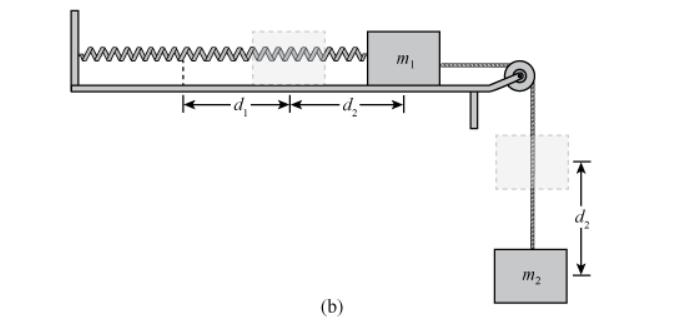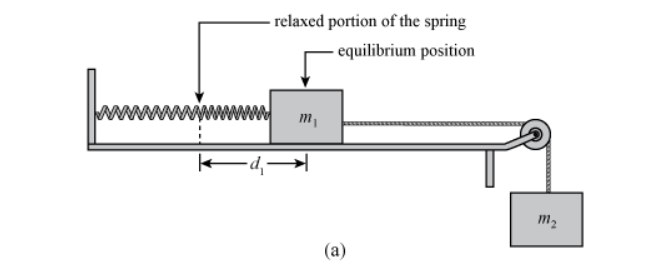You have two equal masses m1 and m2 and a spring with a spring constant k. The mass m1 is connected to the spring and placed on a frictionless horizontal surface at the relaxed position of the spring. You then hang mass m2, connected to mass m1 by a massless cord, over a pulley at the edge of the horizontal surface. When the entire system comes to rest in the equilibrium position, the spring is stretched an amount d1 as shown in figure (a). You are given the following information. The mass m1 = m2 = 0.340 kg. The spring constant k = 230 N/m. (a) Determine the amount the spring is stretched (d1) when m2 is attached to m1.=.145 You now pull the mass m2 down a distance d2 = 4 cm and release it from rest, as shown in figure (b). Determine the following as the two masses travel the distance d2 back to their equilibrium positions. (The masses will overshoot the equilibrium position, but we are focusing our attention on them only as they travel the distance d2.) Determine the work done on the system (m1, m2, and the massless connecting cord) by the spring.=.317 Determine the work done on the system by the force of gravity.=-.133 Determine the work done on the system by the normal force.=0 Determine the net work done on the system.=.184 Determine the work done on m1 by the tension in the cord. Determine the work done on m2 by the tension in the cord.
You have two equal masses m1 and m2 and a spring with a spring constant k. The mass m1 is connected to the spring and placed on a frictionless horizontal surface at the relaxed position of the spring. You then hang mass m2, connected to mass m1 by a massless cord, over a pulley at the edge of the horizontal surface. When the entire system comes to rest in the equilibrium position, the spring is stretched an amount d1 as shown in figure (a). You are given the following information.
The mass m1 = m2 = 0.340 kg.
The spring constant k = 230 N/m.
(a) Determine the amount the spring is stretched (d1) when m2 is attached to m1.=.145
You now pull the mass m2 down a distance d2 = 4 cm and release it from rest, as shown in figure (b). Determine the following as the two masses travel the distance d2 back to their equilibrium positions. (The masses will overshoot the equilibrium position, but we are focusing our attention on them only as they travel the distance d2.)
Determine the work done on the system (m1, m2, and the massless connecting cord) by the spring.=.317
Determine the work done on the system by the force of gravity.=-.133
Determine the work done on the system by the normal force.=0
Determine the net work done on the system.=.184
Determine the work done on m1 by the tension in the cord.
Determine the work done on m2 by the tension in the cord.


Trending now
This is a popular solution!
Step by step
Solved in 3 steps with 3 images







